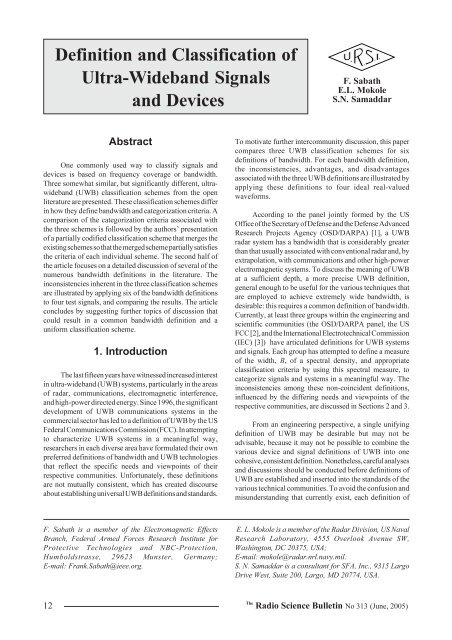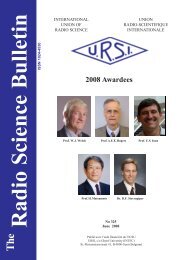Definition and Classification ofUltra-Wideband Signalsand DevicesF. SabathE.L. MokoleS.N. SamaddarAbstractOne commonly used way to classify signals anddevices is based on frequency coverage or bandwidth.Three somewhat similar, but significantly different, ultrawideband(UWB) classification schemes from the openliterature are presented. These classification schemes differin how they define bandwidth and categorization criteria. Acomparison of the categorization criteria associated withthe three schemes is followed by the authors’ presentationof a partially codified classification scheme that merges theexisting schemes so that the merged scheme partially satisfiesthe criteria of each individual scheme. The second half ofthe article focuses on a detailed discussion of several of thenumerous bandwidth definitions in the literature. Theinconsistencies inherent in the three classification schemesare illustrated by applying six of the bandwidth definitionsto four test signals, and comparing the results. The articleconcludes by suggesting further topics of discussion thatcould result in a common bandwidth definition and auniform classification scheme.1. IntroductionThe last fifteen years have witnessed increased interestin ultra-wideband (UWB) systems, particularly in the areasof radar, communications, electromagnetic interference,and high-power directed energy. Since 1996, the significantdevelopment of UWB communications systems in thecommercial sector has led to a definition of UWB by the USFederal Communications Commission (FCC). In attemptingto characterize UWB systems in a meaningful way,researchers in each diverse area have formulated their ownpreferred definitions of bandwidth and UWB technologiesthat reflect the specific needs and viewpoints of theirrespective communities. Unfortunately, these definitionsare not mutually consistent, which has created discourseabout establishing universal UWB definitions and standards.To motivate further intercommunity discussion, this papercompares three UWB classification schemes for sixdefinitions of bandwidth. For each bandwidth definition,the inconsistencies, advantages, and disadvantagesassociated with the three UWB definitions are illustrated byapplying these definitions to four ideal real-valuedwaveforms.According to the panel jointly formed by the USOffice of the Secretary of Defense and the Defense AdvancedResearch Projects Agency (OSD/DARPA) [1], a UWBradar system has a bandwidth that is considerably greaterthan that usually associated with conventional radar and, byextrapolation, with communications and other high-powerelectromagnetic systems. To discuss the meaning of UWBat a sufficient depth, a more precise UWB definition,general enough to be useful for the various techniques thatare employed to achieve extremely wide bandwidth, isdesirable: this requires a common definition of bandwidth.Currently, at least three groups within the engineering andscientific communities (the OSD/DARPA panel, the USFCC [2], and the International Electrotechnical Commission(IEC) [3]) have articulated definitions for UWB systemsand signals. Each group has attempted to define a measureof the width, B, of a spectral density, and appropriateclassification criteria by using this spectral measure, tocategorize signals and systems in a meaningful way. Theinconsistencies among these non-coincident definitions,influenced by the differing needs and viewpoints of therespective communities, are discussed in Sections 2 and 3.From an engineering perspective, a single unifyingdefinition of UWB may be desirable but may not beadvisable, because it may not be possible to combine thevarious device and signal definitions of UWB into onecohesive, consistent definition. Nonetheless, careful analysesand discussions should be conducted before definitions ofUWB are established and inserted into the standards of thevarious technical communities. To avoid the confusion andmisunderstanding that currently exist, each definition ofF. Sabath is a member of the Electromagnetic EffectsBranch, Federal Armed Forces Research Institute forProtective Technologies and NBC-Protection,Humboldstrasse, 29623 Munster, Germany;E-mail: Frank.Sabath@ieee.org.E. L. Mokole is a member of the Radar Division, US NavalResearch Laboratory, 4555 Overlook Avenue SW,Washington, DC 20375, USA;E-mail: mokole@radar.nrl.navy.mil.S. N. Samaddar is a consultant for SFA, Inc., 9315 LargoDrive West, Suite 200, Largo, MD 20774, USA.12The<strong>Radio</strong> <strong>Science</strong> <strong>Bulletin</strong> No <strong>313</strong> (<strong>June</strong>, <strong>2005</strong>)
UWB and the corresponding signal parameters (likebandwidth) should be minimally consistent with otherUWB definitions. In addition, any deviations amongdefinitions should be driven only by technical needs, andthe reasons for the differences should be explained and welldocumented.Defining UWB signals and systems unambiguouslyrequires: (1) a definition of bandwidth, and (2) acategorization scheme in terms of bandwidth. Afteranalyzing the differences and goals of the three existingclassification schemes, a broader and hopefully more unifiedclassification scheme, which may suit the requirements offour specific communities (radar, communication, directedenergy, electromagnetic interaction), is obtained for realvaluedcausal signals by partially merging the definitionsand criteria in Section 3. Even if this proposed mergedscheme is unsuitable for all communities, it may provide afoundation for defining UWB radar.As the definition of bandwidth is a crucial aspect of allclassification schemes, six of the numerous bandwidthdefinitions are discussed in Section 4. Prior to detaileddescriptions of the definitions, properties of real-valuedsignals that are of interest from a practical standpoint andbasic axioms of bandwidth are discussed. In Section 5, sixbandwidth definitions and three classification schemes areapplied to a set of four test signals to illuminate theadvantages, disadvantages, issues, and problems of thesedefinitions and classification schemes. Although thebehaviors of more realistic and less-well-behaved signals –beyond the four well-behaved test signals – will causeproblems for most of the bandwidth measures presented,space limitations force discussions of other signals to bepostponed to future publications. Section 6 provides a briefoutlook on some challenging problems with the articulatedbandwidth measures of this article.2. Historical BackgroundThe rapid development and postulated benefits ofUWB radar led the US Office of the Secretary of Defenseand DARPA to establish a UWB Radar Review Panel toassess UWB technology in the late 1980s. With a focus onUWB radar, the panel introduced the notion of the “fractionalbandwidth” of a radar system as the ratio of its energybandwidth to its center frequency (The OSD/DARPA Paneldefined the energy bandwidth as the frequency range withinwhich some specified fraction, for example, 90% or 99%,of the total signal energy lies.) Based on this parameter, thepanel agreed on the following definition:An [sic] UWB radar is any radar whose [sic] bandwidthis greater than 0.25 regardless of the center frequency orthe time-bandwidth product.Although the panel observed that the choice of 0.25 asthe defining value was largely arbitrary, their definition ofUWB radar does, in some sense, represent the demarcationbetween conventional narrowband techniques and the needto employ special (UWB) techniques. In this sense, impulseradars are a special class of UWB radars that typically havevery high peak powers and short pulse durations.In response to the rapid development of UWBcommunications of the past decade, the US FCC reviewedthe CFR Part 15 rules with regard to UWB transmissionsystems. Although the OSD/DARPA recommendationswere evidently used as a basis, the FCC proposed thefollowing somewhat different definition for UWBtransmitters ([1], p. 768, §15.503):A UWB transmitter is an intentional radiator that, at anypoint in time, has a fractional bandwidth equal to orgreater than 0.20 or has a bandwidth equal to or greaterthan 500 MHz, regardless of the fractional bandwidth.In the FCC definition, the bandwidth is the frequencyband bounded by the points that are 10 dB below the highestradiated emission, as based on the complete transmissionsystem, including the antenna. The FCC and OSD/DARPAdefinitions differ on three points: (1) the selection of 0.20instead of 0.25 as the threshold separating UWB andconventional systems, (2) the additional 500 MHz constraint,and (3) the definition of bandwidth. The difficulty with theFCC definition is that it classifies the WARLOC radar [4]– which has a 600 MHz bandwidth at a center frequency of94 GHz – as UWB, whereas the radar community considersWARLOC to be narrowband because the fractionalbandwidth is 0.0064. Moreover, the FCC definitionimplicitly assumes that the upper and lower 10 dB pointsexist and are unique, which is not always the case. Forexample, UWB communication systems use signals withspectra that have gaps in the signal band to protect othernarrowband services. Consequently, such spectra havemore than two 10 dB points. In contrast, a directed-energysystem developer is interested in impulse-like waveformsthat contain significant spectral amplitudes at 0 Hz. If onlypositive frequencies are considered, the FCC definitionfaces the problem that only one (the upper) 10 dB pointexists. Because the 10 dB bandwidth definition divergesfrom the commonly used filter/signal definition of bandwidth(3 dB points), the FCC definition, which seems to bemarket driven, is inconsistent with well-establisheddefinitions and standards. Moreover, the FCC’s threechanges in UWB criteria from the OSD/DARPA definitionshave greatly increased the number of unlicensedradiofrequency systems that can be called UWB, whicheffectively has opened spectrum usage to many moreintentional radiators.Through the International ElectrotechnicalCommission (IEC), the high-power directed-energycommunity has been formulating a standard (IEC 61000-2-13) with an alternate classification scheme for UWB [3].The IEC scheme uses a modified version of the OSD/DARPA definition that is based on the community’sexperiences with impulse-radiating systems. Since manyimpulse waveforms have fractional bandwidths exceedingThe<strong>Radio</strong> <strong>Science</strong> <strong>Bulletin</strong> No <strong>313</strong> (<strong>June</strong>, <strong>2005</strong>) 13
- Page 1 and 2: Radio Science BulletinISSN 1024-453
- Page 3 and 4: EditorialJune in December?Yes, this
- Page 5 and 6: URSI Accounts 2004In 2004, a year p
- Page 7 and 8: EURO EUROA2) Routine Meetings 7,315
- Page 9 and 10: URSI AWARDS 2005The URSI Board of O
- Page 11: Guest Editors’ RemarksOn February
- Page 15 and 16: Radar / CommunicationsBand TypeElec
- Page 17 and 18: of the spectrum is required to comp
- Page 19 and 20: Bandwidths f l / GHz f h / GHz B F
- Page 21 and 22: Figure 3a. A time-domain representa
- Page 23 and 24: Bandwidths f l / f c f h / f c B F
- Page 25 and 26: Bandwidth f l / f c f h / f c B F C
- Page 27 and 28: Quantitative Comparison BetweenMatr
- Page 29 and 30: Next, construct the ‘filtered’
- Page 31 and 32: whereH[ P ] [ U][ ][ V] ,N= Σ (27)
- Page 33 and 34: CPU Time [sec]250200150100MPMSS1SS2
- Page 35 and 36: -10-20MPMSS1SS2-30-40RMSE [dB]-50-6
- Page 37 and 38: RMSE [dB]-45-50-55-60-65-70MPMSS1SS
- Page 39 and 40: An Ultra-Compact Impulse-Radiating
- Page 41 and 42: Figure 3. UCIRA-1 splitter/balun.th
- Page 43 and 44: Figure 9. UCIRA-2 in stowed configu
- Page 45 and 46: activated first in the deployment s
- Page 47 and 48: Figure 20. Theoretical gain ofUCIRA
- Page 49 and 50: Triennial Reports CommissionsCOMMIS
- Page 51: y the Special Section Editors, and
- Page 55 and 56: 3.2 Activities of URSI-Commission C
- Page 57 and 58: It already has been decided that th
- Page 59 and 60: SCOR (Scientific Committee on Ocean
- Page 61 and 62: COMMISSION GThis triennium report w
- Page 63 and 64:
GNSS-LEO occultation is a very impo
- Page 65 and 66:
CPEA Contacts: Shoichiro Fukao, Pro
- Page 67 and 68:
The group wishes to continue as an
- Page 69 and 70:
total of 109 oral papers (24 thereo
- Page 71 and 72:
surface, to compensate for the rema
- Page 73 and 74:
XXVIIIth General AssemblyNEWLY ELEC
- Page 75 and 76:
Décide1. d’accepter l’invitati
- Page 77 and 78:
satellite observation, bottomside s
- Page 79 and 80:
ETTC ‘05EUROPEAN TEST AND TELEMET
- Page 81 and 82:
IRI 2005 WORKSHOPNEW SATELLITE AND
- Page 83 and 84:
financial and logistics issues conn
- Page 85 and 86:
CONFERENCE ANNOUNCEMENTS36 TH COSPA
- Page 87 and 88:
December 2006APMC 2006 - 2006 Asia-
- Page 89 and 90:
The Journal of Atmospheric and Sola
- Page 91 and 92:
SCIENTIFIC COMMISSIONSCommission A
- Page 93 and 94:
Commission E : Electromagnetic Nois
- Page 95 and 96:
Commission J : Radio AstronomyChair
- Page 97 and 98:
URSI MEMBER COMMITTEESAUSTRALIA Pre
- Page 99 and 100:
ALPHABETICAL INDEX AND CO-ORDINATES
- Page 101 and 102:
BRUSSAARD, Prof. dr.ir. G., Radicom
- Page 103 and 104:
FEICK, Dr. R., Depto. de Electronic
- Page 105 and 106:
SAUDI ARABIA, Tel. +966 1-4883555/4
- Page 107 and 108:
E-mail loulee@nspo.gov.tw (94)LEE,
- Page 109 and 110:
O’DROMA, Dr. M., Dept. of Electri
- Page 111 and 112:
+30 2310 998161, Fax +30 2310 99806
- Page 113 and 114:
TURSKI, Prof. A., ul. Krochmalna 3
- Page 115 and 116:
Information for authorsContentThe R
















